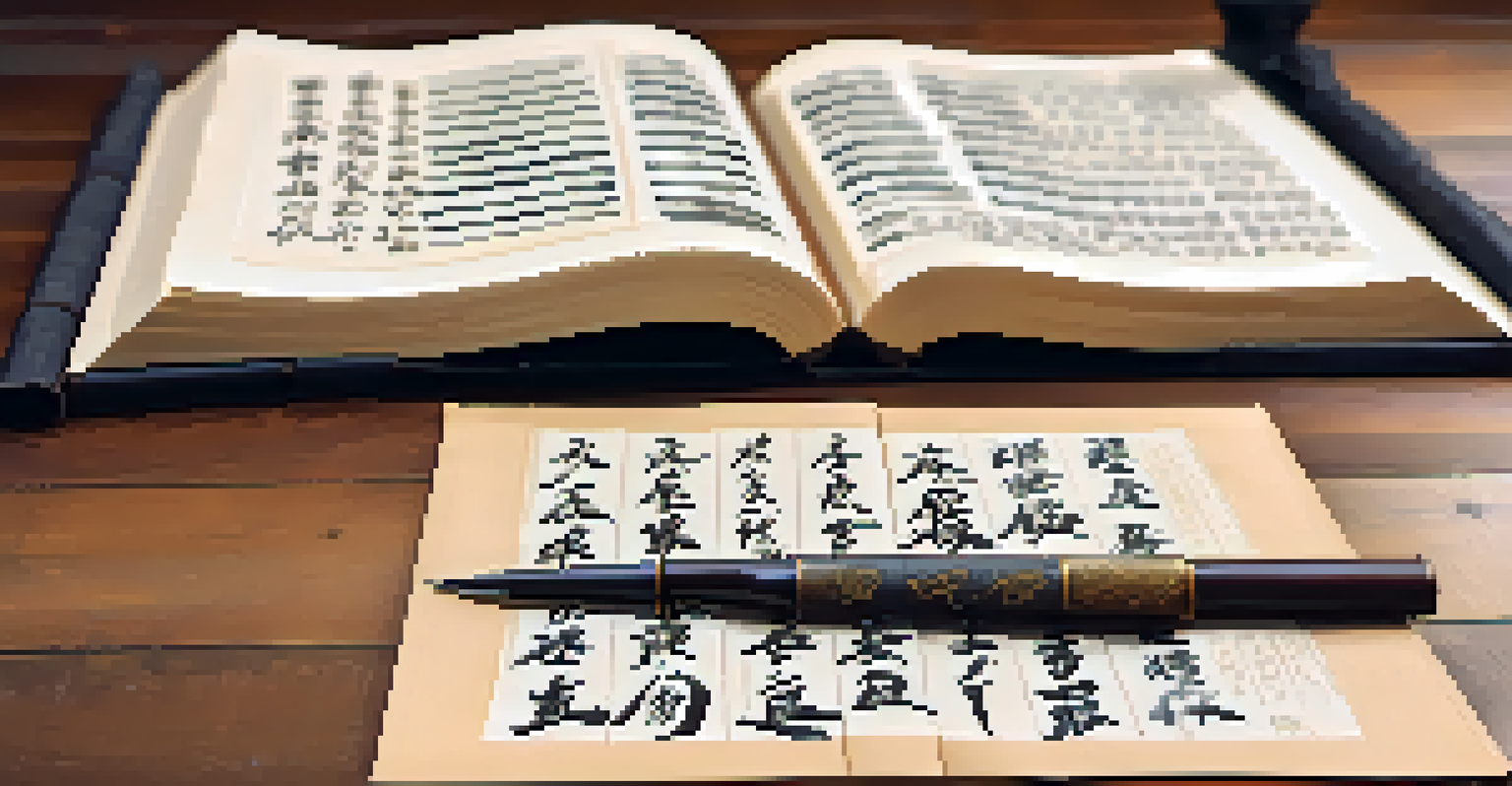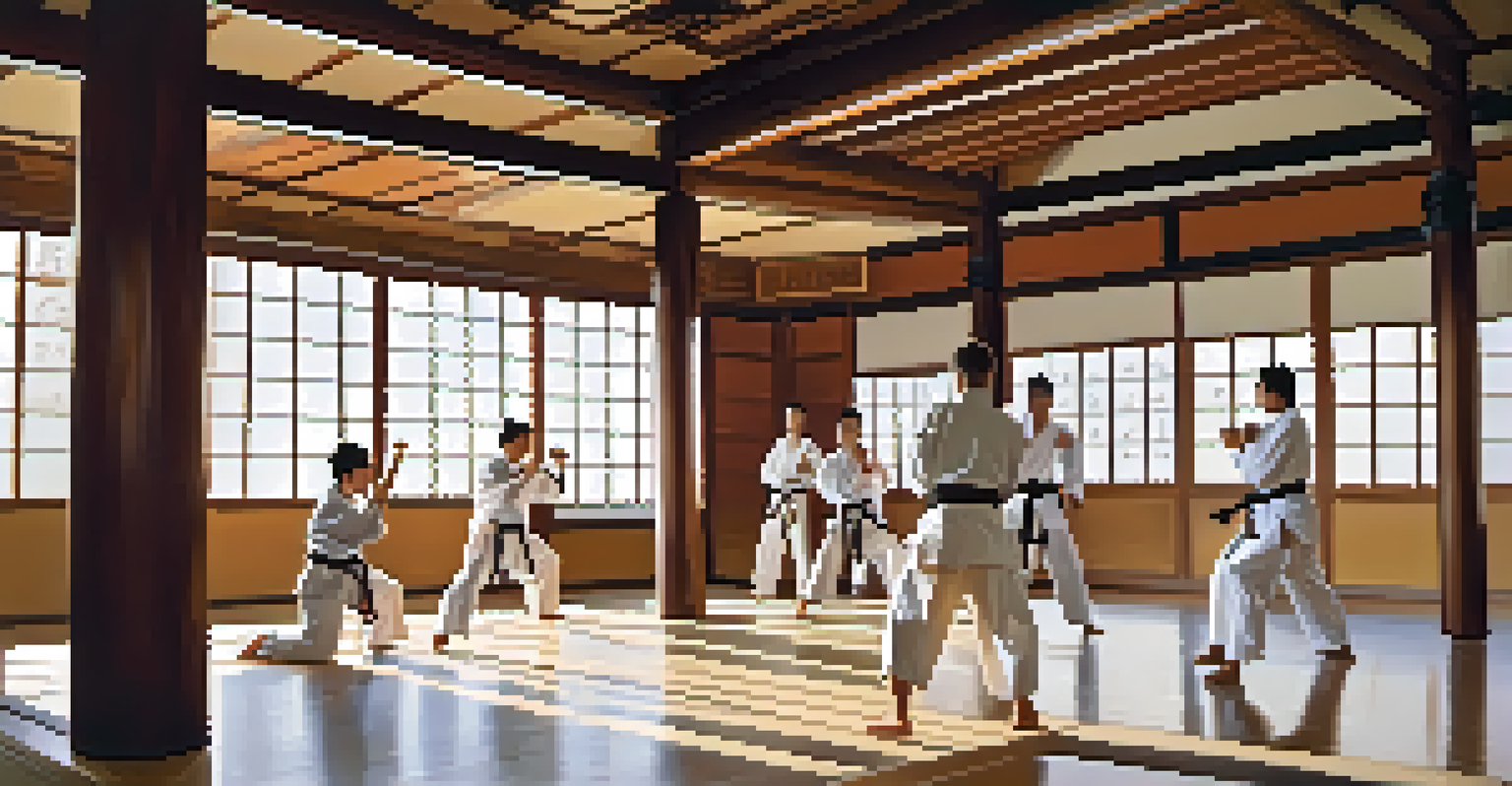Historical Martial Arts: Textual Evidence from Ancient Scripts

Understanding Historical Martial Arts through Written Records
Historical martial arts are practices rooted in ancient fighting techniques, largely documented through various texts. These writings provide insights into how combat was approached during different eras and cultures. By analyzing these scripts, we can better understand the philosophies, techniques, and training methods that shaped martial arts as we know them today.
The greatest victory is that which requires no battle.
For instance, texts from ancient China, like the 'Book of Five Rings' by Miyamoto Musashi, illustrate not just combat strategies but also the mindset required for a warrior. Similarly, the 'Art of War' by Sun Tzu emphasizes the importance of strategy and adaptability in combat situations. Such writings serve as invaluable resources for both historians and martial artists alike.
Moreover, these historical documents create a bridge connecting practitioners to their roots. They highlight the evolution of martial arts over centuries, showcasing how cultural exchanges influenced styles and techniques. As we explore these ancient texts, we uncover the stories and traditions that have been passed down through generations.
Key Ancient Texts and Their Impact on Martial Arts
Several ancient texts stand out for their significant contributions to the understanding of martial arts. The 'Bubishi,' often referred to as the 'Bible of Karate,' is a comprehensive guide that combines philosophy, medicine, and combat strategies. Originating from China and influencing martial arts in Japan, this text illustrates the interconnectedness of different cultures in shaping martial practices.

Another pivotal work is the 'Hagakure,' a guide for samurai that delves into bushido, the way of the warrior. Its teachings emphasize discipline, honor, and the mental aspects of combat, reflecting the holistic approach martial artists strive for even today. Such texts not only instruct but also inspire practitioners to adopt a warrior's mindset.
Historical Texts Shape Martial Arts
Ancient writings provide crucial insights into the philosophies, techniques, and training methods that influence modern martial arts.
These writings underscore how martial arts are not just physical activities but also rich cultural narratives. By examining these texts, we gain a greater appreciation for the values and philosophies that underpin martial arts traditions globally. They provide context, allowing us to see how historical perspectives inform modern practices.
The Role of Oral Tradition in Historical Martial Arts
While written texts are vital, oral traditions have played a crucial role in preserving martial arts history. Many techniques and philosophies were passed down verbally before they were ever documented, creating a rich tapestry of knowledge. This oral transmission often included stories, parables, and teachings that emphasized practical application and moral lessons.
In martial arts, the mind is the greatest weapon of all.
For example, in many indigenous martial arts, instructors would share wisdom through storytelling, embedding lessons within narratives that are easier to remember. This method not only ensures the survival of techniques but also cultivates a strong sense of community among practitioners. It highlights the importance of mentorship and the personal relationships that are formed in martial arts training.
As societies evolved, the integration of both oral and written traditions became essential for the survival of martial arts. Today, many schools honor this dual heritage, combining the teachings of ancient texts with the stories and experiences of their instructors. This blend enriches the learning experience, making martial arts a living tradition.
Martial Arts Techniques Documented in Historical Texts
Historical manuscripts often provide detailed descriptions of martial arts techniques. From grappling methods in 'The Art of War' to striking techniques in the 'Bubishi,' these texts serve as instructional guides for practitioners. They offer insights into the mechanics of movements, stances, and the underlying principles that govern effective combat.
For instance, the 'Sankukyo' from Japan outlines various strikes, blocks, and counters, showcasing the systematic approach to training. Such documentation allows modern martial artists to trace their techniques back to historical roots, enhancing their understanding and execution of these movements. It’s fascinating to see how some techniques have stood the test of time while others have evolved.
Oral Traditions Preserve Techniques
Oral storytelling has been essential in transmitting martial arts knowledge, creating a strong community and mentorship among practitioners.
Moreover, these texts can also reveal the philosophical aspects of martial techniques. They often emphasize the importance of timing, distance, and awareness—concepts that are just as relevant in today’s training. By studying these ancient techniques, practitioners not only improve their physical abilities but also deepen their appreciation for the art form.
Cultural Influences Reflected in Martial Arts Texts
Martial arts texts are also a reflection of the cultures from which they originate. For example, Chinese martial arts texts often incorporate elements of Taoist philosophy, emphasizing harmony and balance. This cultural influence shapes not only the techniques but also the mindset that practitioners adopt, promoting a holistic approach to training.
In contrast, Japanese martial arts literature frequently highlights the samurai code, portraying values such as honor and loyalty. These cultural narratives are essential in understanding how martial arts practices were designed to fit within societal norms and expectations. They illustrate the interplay between martial skills and ethical conduct, a theme common across many martial arts traditions.
By examining these cultural influences, we gain a clearer picture of how martial arts have evolved over time. It highlights the importance of context in the interpretation of techniques and philosophies, reminding us that martial arts are as much about culture and identity as they are about physical ability.
The Evolution of Martial Arts Through Historical Evidence
Historical evidence shows that martial arts have undergone significant transformations over the centuries. As societies changed, so did their martial practices, often influenced by warfare, trade, and cultural exchanges. This evolution is documented in various texts that capture the shifts in techniques, philosophies, and training methods.
For example, the transition from traditional weapons to empty-hand techniques can be traced through ancient manuscripts. These changes often reflect broader societal shifts, such as the rise of urbanization or changes in warfare tactics. As new challenges arose, martial arts adapted, showcasing the resilience and creativity of practitioners throughout history.
Cultural Context Influences Practices
Martial arts texts reflect the cultural values and societal norms of their origins, emphasizing the interplay between martial skills and ethical conduct.
Understanding this evolution helps modern martial artists appreciate the depth of their practice. It allows them to recognize the influences that have shaped their styles and develop a broader perspective on martial arts as a dynamic, living tradition. This historical context enriches their training experience, providing a sense of continuity with the past.
Preserving Historical Martial Arts for Future Generations
The preservation of historical martial arts is essential for ensuring that future generations can access this rich heritage. As modern practices continue to evolve, it becomes increasingly important to document and teach the traditional techniques and philosophies outlined in ancient texts. This preservation can take many forms, from formal training programs to community workshops.
Moreover, fostering an appreciation for historical texts among practitioners can deepen their connection to martial arts. Encouraging students to study these writings not only enhances their technical skills but also instills a sense of respect for the traditions that came before them. This holistic approach ensures that the essence of martial arts is maintained even as styles evolve.

Ultimately, the task of preserving historical martial arts is a collective effort. By sharing knowledge and resources, martial artists can create a vibrant community that honors the past while embracing the future. This commitment to preservation ensures that the valuable lessons contained in ancient scripts continue to inspire and guide practitioners for years to come.